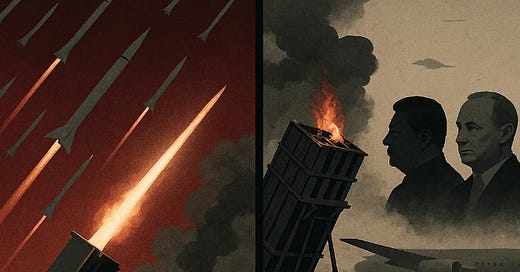Missiles, Alliances, and the Exhaustion of Defense
Iran’s missile saturation campaign reveals the brittle economics of defense, while a new Axis of Autocracy quietly solidifies behind the scenes.
Good morning,
It’s been a relatively quiet week in space news—which is good because we want to talk about Israel and Iran and several recent and ongoing developments in the conflict there.
National Security Arbitrage
Most importantly, we’re seeing a tremendous example of national security arbitrage. Last week, we mentioned that Iran’s April 2024 attack on Israel was a prime example of this concept, but the past 6 days of fighting prove the concept even better. The Wall Street Journal spoke with a U.S. official that admitted that Israel is running low on its Arrow missile systems, which are critical to intercepting ballistic missiles. And Israel is not alone. The United States is also burning through its munitions as it helps Israel in defending itself firing SM-3 and SM-6 missiles.
Last year, we took the commander of Army Futures Command, General James Rainey, to task for expressing that technology was favoring the defense. We argued that technology was enabling the national security arbitrage through the mass production of inexpensive weapons negating the relative strength of the defense. And now, that’s playing out in Israel as Iran continues to saturate Israeli airspace with missiles.
In the past six days, it’s estimated that Iran has expended about 10% of its ballistic missiles. While Israeli and U.S. air defenses have effectively blocked about 90% of those (which is itself down from last year’s 99% efficacy), at some point the interceptors will be exhausted. That point in time will come long before Iran exhausts its magazine.
To try and mitigate the risk of Iran’s numerical superiority, Israel has focused much of its attacks on ballistic missile systems and infrastructure on the ground in Iran. That has damaged up to about 30-35%. Nevertheless, that’s not sufficient to make up the difference and the Israeli munitions have largely been precision guided munitions or smart munitions, which remain relatively expensive.
The Risk of U.S. Involvement
The United States is already playing a role here, albeit principally one focused on protection and defense of Israel.
President Trump left the G-7 summit prematurely yesterday to return to Washington. This morning he met in the Situation Room with advisors as he considers a much more proactive role for U.S. forces—perhaps directly engaging Iran.
The pros of such involvement would include the ability to further destroy Iran’s weapons before they can overwhelm our collective defenses and potentially aid in truly setting back Iran’s nuclear program elements operating in hardened and deeply- buried facilities.
The cons and the risks of such involvement, however, far outweigh those potential benefits. Iran unquestionably has pre-planned targets on every major U.S. interest in the region including our military bases, embassies, and business interests. The U.S. public seems resistant to such a direct role. And, it will waste critical resources that are already stretched thin and take away from our broader strategic efforts to focus on managing China’s global influence and ability to militarily control the western Pacific.
We agree that a nuclear Iran is unacceptable to the regional and global order. We agree that we must help protect Israel against the existential threat that Iran poses. We have no doubt that the United States and Israel, with or without other allies and partners, would prevail over Iran. And, if Iran directly attacks U.S. interests we believe we should respond with overwhelming force. But, we should not initiate a costly and unnecessary campaign.
The Ascending Axis of Autocracy
The final observation that we want to address relates to the shifting alignments and strength of alliances. During World War II, the Allied Powers were far better integrated and synchronized than the Axis Powers. The Allies put aside significant differences in ideologies to focus on the systematic restoration of territorial sovereignty and the rejection of the totalitarian and fascist regimes. By contrast, Germany, Italy, and Japan formed a much looser confederacy.
The necessity of strong Alliances was further demonstrated during the Second World War when the American, British, Dutch, Australian Command (ABDACOM) failed miserably in protecting interests in Southeast Asia. ABDACOM was a far looser, less organized attempt at integrating partners without achieving important synergies like Unity of Command.
Most analysts look at the alignment among China, Iran, North Korea, and Russia as weak and opportunistic only. While it is clearly no NATO, it is coalescing far more than the Axis Powers did.
While Russia is, so far, sitting out of the conflict in the Middle East, China has delivered three aircraft loads of cargo to Iran. What that cargo is, is anybody’s guess at this point. Nevertheless, we’re witnessing increasing cohesion among the four powers that comprise the Axis of Autocracy.
Even before this conflict we witnessed growing ties. North Korea and China are fighting in Ukraine on behalf of the Russians. Iran is helping Russia build attack drone manufacturing plants. Russia is sharing space technology with North Korea. China and Iran are providing advanced weapons and intelligence to Yemen’s Houthi fighters.
We expect that this Axis of Autocracy will only grow more united with time.
Alright, on to the news!
News Headlines
In dramatic turnabout, President Trump assembles Nat’l Security briefing and considers joining Israel’s attacks on Iran (BBC)
Trump hints at U.S. involvement saying that 'we' control the skies over Iran and that 'we' know where Ayatollah Khamanei is (AP)
U.S.S. Nimitz aircraft carrier diverted from IndoPacific to Middle East amid Iran-Israel conflict (MT)
President Trump departs G7 meeting prematurely, after criticizing the Group's 2014 decision to suspend Russia's involvement and making a text encouraging Iranians to evacuate Tehran (RT)
Iran's MOIS cracks down as paranoia of Mossad spy infiltration grows (CNN)
Iran signaled willingness to talks as Israel strikes continue (WSJ)
China sends mystery transport planes into Iran (TT)
Israel is running low on Arrow missile interceptors (WSJ)
Pentagon realigns combatant commands to place Greenland in NORTHCOM area of responsibility (DN)
Appeals court appears poised to back federal control of Nat'l Guard in California (AP)
70,000 people have signed up for Trump's $5M 'golden visa' (FT)
Satellites
Launches
Upcoming Launches
Space News
Satellite photos reveal damage to Iranian missile bases and nuclear facilities after Israeli strikes (AP)
Space Force pushes first launch of next-gen missile warning to 2026 (DN)
Space Force receives first two units of Meadowlands offensive satellite jammer (DS)
Space station air leaks trigger delay to private astronaut mission (RT)
James Webb Space Telescope finds oldest, coldest planet yet in chaotic system (TDB)
York's experimental comms satellite ready for launch (DN)
Foreign Space News
China's CAS Space performs Kinetica-2 first-stage hot fire test ahead of first launch and cargo demo (SN)
Taiwan believes that China is bringing grey zone warfare to space (DO)
China launches new seismo-electromagnetic satellite with European partners (SN)
China's Tianwen 2 spacecraft sends home first photo as it heads for mysterious 'quasi-moon' asteroid (SP)
Chinese satellite achieves 5 times Starlink speed with 2-watt laser from 36,000km orbit (MP)
ESA moving ahead with 'resilience from space' satellite imaging program (SN)
ESA's Solar Orbiter gets world-first views of the Sun's poles (ESA)
Israel intercepts Iranian missile in space demonstrating Arrow 3's exoatmospheric interception capabilities (ET)
Japan's Honda conducts surprise first launch of reusable rocket entering the space race (GM)
Deal Flow
VC
French SSA company Look Up raised a $57.6M Series A round led by ETF Partners (SN)
Logos Space Services raised a $50M Series A round led by U.S. Innovation Technologies to advance plans for a 4,000 satellite broadband constellation (SN)
Muon Space raised a $44.5M Series B Extension led by Congruent Ventures--bringing the total B round to $146M--to continue building its LEO satellite constellation (TFN)
Opportunities
NASA is seeking information from commercial companies about Earth proximity relay communication and navigation capabilities that it can use for emerging agency science missions (NASA)
The World Space Elevator Competitions announces first ever global space elevator challenge kickoff event seeking students and space enthusiasts as participants (BW)
Editor’s Picks
Outside Analytics CEO Ben Tarr outlines four essentials for space superiority.
Lighter Side
Keep Building,
BOF









One key element that you have left out of your opinion segment: The key objective for Israel, US and quite frankly the world, is to prevent Iran from having a nuclear weapon. Also, by dismantling Iran's capability, we are practically reducing China's and Russia's leverage.